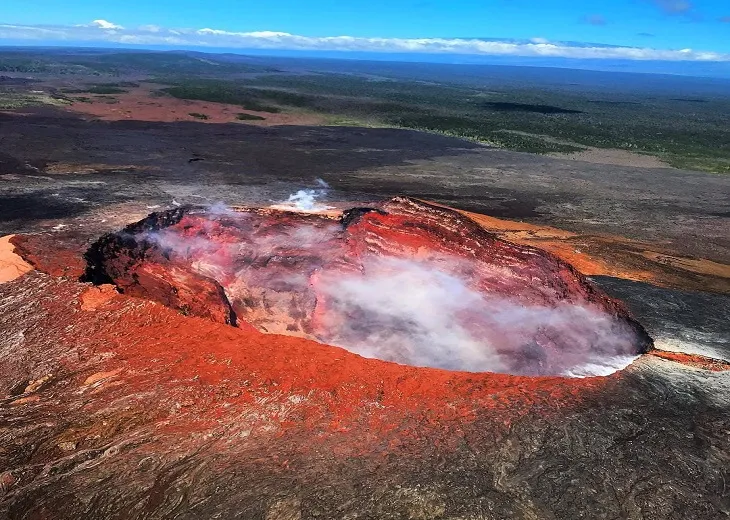Hawaii, a paradise island in the Pacific Ocean, is famous not only for its long white-sand beaches and captivating Hula dances but also for being home to magnificent volcanoes. Among them, Kilauea stands out as a symbol of natural power and scientific curiosity. But Kilauea is more than just a volcano; it holds countless fascinating secrets you may have never heard of. Join “Travel the World” to uncover the unique mysteries of this volcano!
Kilauea – The World’s Most Active Volcano
Kilauea, meaning “spewing” or “much spreading” in Hawaiian, is a shield volcano located on the island of Hawaii, the largest island in the Hawaiian archipelago. Not only is it one of the most active volcanoes in the world, but Kilauea is also a popular tourist destination, attracting millions of visitors each year to admire its majestic beauty and learn about its unique geological activity.

Turbulent History of Formation and Development
Kilauea was formed approximately 300,000 to 600,000 years ago and emerged above sea level about 100,000 years ago. This volcano is part of the Hawaiian-Emperor seamount chain, created by a geological hotspot deep within the Earth’s mantle. Throughout its history, Kilauea has experienced many major eruptions, changing the surrounding landscape and contributing to the growth of the island of Hawaii.
Notable Eruptions in History
Kilauea is famous for its long-lasting and intense eruptions. One of the most notable was the eruption that lasted from 1983 to 2018. For 35 years, this volcano continuously spewed lava, creating rivers of fire flowing into the sea, expanding the land area, and causing significant impacts on the environment and local communities.
The 2018 eruption also caused considerable damage, destroying hundreds of homes and significantly altering the surrounding landscape. However, it also provided opportunities for scientists to study volcanic activity and the process of new land formation.
Impact on Hawaii’s Unique Ecosystem
Kilauea’s activity has a profound impact on Hawaii’s ecosystem. Erupting lava creates new land, providing a foundation for the development of plant and animal species. However, it can also destroy habitats and cause air pollution.
Some plant and animal species have adapted to the harsh environment around Kilauea, becoming endemic to this area. For example, the Ohia Lehua tree is a species capable of growing on new volcanic soil, and the Apapane bird is a honeycreeper that frequently appears near eruption areas.
Other Interesting Facts About Hawaii You Should Know
Besides Kilauea, Hawaii has many other fascinating things waiting for you to discover:
Diverse and Rich Terrain
Hawaii not only has volcanoes but also towering cliffs, deep canyons, and beautiful beaches. The cliffs on the northeast coast of Molokai are up to 1,150m above sea level, among the highest sea cliffs in the world. Waimea Canyon on Kauai Island is known as the “Grand Canyon of the Pacific” with its majestic and breathtaking beauty.

Uninhabited and Pristine Islands
Among the eight main islands of Hawaii, some are uninhabited, offering a sense of wilderness and mystery. Kahoolawe Island is the smallest and uninhabited island, serving as an important nature reserve.
Unique and Captivating Indigenous Culture
Hawaii is home to two main indigenous groups, Kanaka Maoli and Kanaka Oiwi. Hawaiian culture is rich and diverse, expressed through music, dance, art, and traditional customs. The Merrie Monarch Festival is one of the largest festivals in Hawaii, celebrating Hawaiian culture and Hula arts.
Kona Coffee – The Most Expensive Coffee in the World
Hawaii is the birthplace of the famous Kona coffee, grown on the volcanic slopes of Hualalai and Mauna Loa. Kona coffee has a distinctive, delicious flavor and is considered one of the best coffees in the world.
Traveling to Kilauea: Important Notes
If you plan to visit Kilauea, keep the following in mind:
- Learn about the volcano’s activity: Before you go, check for updated information on eruption status and safety warnings from authorities.
- Prepare appropriate clothing and equipment: Bring hiking shoes, long-sleeved clothing, a hat, sunglasses, and sunscreen.
- Follow safety regulations: Always stay on designated trails and do not cross restricted areas.
- Respect the environment: Do not litter and avoid impacting the local ecosystem.
Conclusion
Kilauea volcano is not only a geological wonder but also an important part of Hawaii’s culture and history. Hopefully, this article has provided you with interesting and useful information about this unique volcano. If you have the opportunity to visit Hawaii, don’t miss the chance to explore Kilauea and experience the wonders it offers. Are you excited to set foot in this land?